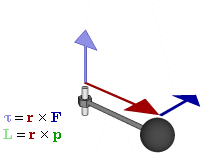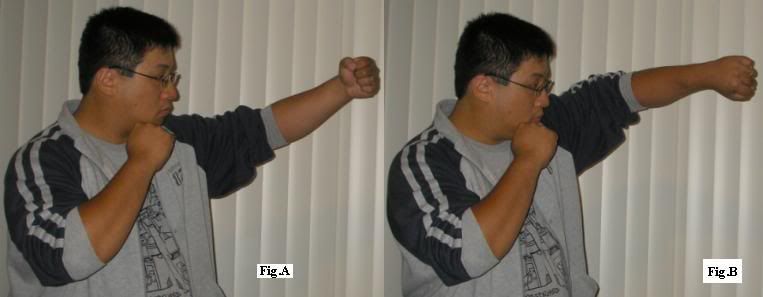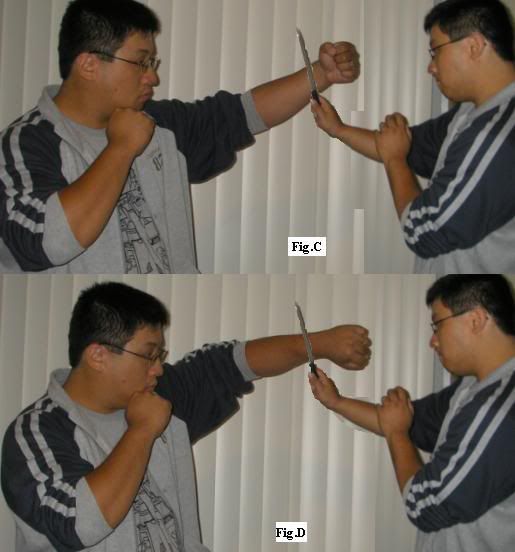-
22nd February 2008, 01:35 PM
#1


Originally Posted by
GoktimusPrime

You mean Romanisation.

Thanks! "Romanisation" is the term I should have used.
-
4th March 2008, 12:17 AM
#2
 Training With Noobs
Training With Noobs
Training With Beginners
I haven't been going to my regular school because the venue that they use for Sunday classes has been repeatedly damaged by hail and rain - although I'm tentatively considering changing one of my training days from Sunday to some other day (it would have to be either Tue or Fri... considering changing to Fri). But anyway, in the meantime I've been going to another local place every Monday just to keep up with training and exercise.
I've only been at this school for a few months and I've never graded - I haven't even purchased a uniform and I don't even hold a white belt.  So for these reasons I'm usually stuck practising with white belts... occasionally higher belts, but not too often. Whenever I train with someone, I'm always keen to exchange information with them... I like to give them tips or pointers if I see the need arising, or sometimes just generally exchange notes (which is more fun with more experienced fighters). Some newbs don't think much of this - I think some of them lack the experience to appreciate some of the advice I'm giving them, others have trouble understanding it because this school is primarily focused on competition cage-fighting, which has a completely different mentality from self-defence fighting which is what I exclusively train for (comp fighting and self defence go together like oil and water :/). Other newbs - i.e.: those who have come to actually learn self defence, are more appreciative of the advice I give them.
So for these reasons I'm usually stuck practising with white belts... occasionally higher belts, but not too often. Whenever I train with someone, I'm always keen to exchange information with them... I like to give them tips or pointers if I see the need arising, or sometimes just generally exchange notes (which is more fun with more experienced fighters). Some newbs don't think much of this - I think some of them lack the experience to appreciate some of the advice I'm giving them, others have trouble understanding it because this school is primarily focused on competition cage-fighting, which has a completely different mentality from self-defence fighting which is what I exclusively train for (comp fighting and self defence go together like oil and water :/). Other newbs - i.e.: those who have come to actually learn self defence, are more appreciative of the advice I give them.
One white belt that I trained with last week told me that he really enjoyed training with me and told me that I was a "very good training partner." He explained to me that most other more experienced/senior students simply focus on their own training and improvement without really caring about helping him as a less experienced student. i.e.: they're happy to simply have him play the role of attacker or defender, but don't give him explicit advice on how to improve his techniques. Often they will pwn him without stopping to explain why and how they were able to do it and also how he could counter that pwnage technique.
Whenever I pull a move that pwns my less-experienced partner, I will usually stop and try to explain to them why I was able to do it. For many newbs martial arts applications can seem almost like "magic" because all they see is a flurry of movement, and suddenly they've lost. They don't understand the process by which they were defeated - and even when people explain how they were beaten, they seldomly explain how they could counter that technique. Every technique has a counter-technique (and counter-counters, and counter-counter-counters etc).
Newbs are often led to believe that if they screw up a technique, that all is lost, and I often see them despairing. Like you throw a hit at them, and they might screw up their block and they go, "aw crap," but I try to tell them not to give up hope and show them that there are always other techniques you can fall back on when others fail - i.e.: if Plan A fails execute Plan B, if Plan B fails execute Plan C etc etc. I've found that in doing so, it really builds the beginner's confidence and enthusiasm... and generally they're appreciative of the fact that I'm willing to openly share my knowledge with them.
The culture of secrecy in martial arts, especially in Kung Fu, is really silly in the context of modern day society. In the old days masters were reluctant to reveal all of their knowledge to students because they were afraid that their students may use their techniques to betray them and usurp leadership of the school. As a result, many styles faded into extinction and to this day it's really really hard to find any decent traditional schools of Kung Fu (well, it's really hard to find any decent martial arts schools period). You actually see some martial arts schools where students are told NOT to teach their martial arts to anyone outside of their school... sometimes they're not even allowed to show their techniques outside of their school unless it's an organised public demonstration. IMO that's a load of bollocks - in this day and age where the culture of challenging your teacher to a death match to win ownership of the school is long gone I just don't see the need in maintaining the culture of secrecy. But I digress...
The point I'm making is that whenever you train with a beginner-level student be helpful and share your knowledge with them! Don't be overtly too picky - correct them within the context of their relative skill level. And when correcting them, give a brief explanation as to why what you're showing them is more correct. I don't bother correcting people if they're doing a technique differently from me so long as I don't see any inherent flaws in the technique. By 'flawed' techniques I mean correct them if they're moving in a way that exposes them to danger (e.g.: moving in a way that leaves your nuts open! <---veeerrrrry common mistake I see, especially in schools that do comps). Sometimes I see other people correcting someone on a technique just because it looks different, but otherwise isn't effecting the outcome of the application... what's the point? If the technique works and it isn't exposing the exponent to harm then who cares? (this is especially important when I'm training with people from different styles - which is the case at this school I've been attending. I don't correct my partners on 'stylistic' differences unless they specifically ask me).
Helping newbs is beneficial for everyone. It's obviously beneficial for the newb who would be getting more benefit from training with a more experienced/senior student (instead of just getting blindly pwned without understanding why/how). It's beneficial for the more skilled fighter because you often teach yourself stuff when teaching others (it's good revision for more basic techniques too). And it's beneficial for the teacher because you're making life easier for him/her - especially in larger classes where his/her attention is more divided.
Sparring With Noobs
I sparred today at the aforementioned school, and because I'm new there I sparred with a whitebelt. Sometimes when I spar with low level students I will set a "handicap" usually by placing one or both hands behind my back which means that I only allow myself to fight with one or no hands. It's beneficial for my partner because it gives them an upper hand (and better fighting chance to whup me) and it's beneficial for me because I can work on my core fighting technique (all fighting comes from your footwork where you float like a butterfly and sting like a bee (or at least try to  )).
)).
Once I sparred with an "extreme noob" (i.e.: he wasn't just inexperienced in martial arts, he was just generally unco) so I not only restricted my hands but I also intentionally distracted myself by singing the tune to Strauss' Blue Danube (still managed to majorly pwn my opponent which had all the other students laughing  ). Another time I was sparring with someone even worse so I had my opponent tie my hands behind my back and asked him to blindfold me (still pwned him though).
). Another time I was sparring with someone even worse so I had my opponent tie my hands behind my back and asked him to blindfold me (still pwned him though).
-
5th March 2008, 01:27 PM
#3

hey gok, have you ever been in a real street fight? HARDCORE!
-
5th March 2008, 05:11 PM
#4

I'd rather not discuss that publicly. As Mr Miyagi taught us, we train to fight so that we may never have to. Learning self defence is a lot like buying insurance or wearing a seat belt... you hope that you'll never need it, but when it happens you're mighty glad that you have it.
When buying insurance you want to get something decent. Fortunately safety equipment and devices like seatbelts, helmets etc comply to a regulated government standard. There is no such standard for martial arts.
If you're interested in training for practical self defence, I would personally recommend training in a traditional style and preferably at a school whose students do NOT compete in matches/tournaments. I'm quite skeptical of this whole "mixed martial arts" business. It promises a lot but I've yet to see any substantial delivery - and in an age of post-submachinegun warfare, I doubt we'll ever see that promise fulfilled.
Competition fighting: Not recommended in a real fight

Traditional fighting: Battle-hardened and proven in centuries of warfare

-
6th April 2008, 07:30 PM
#5

Another discussion about roundhouse punches - what I consider to be the 'right' and 'wrong' way of doing them, or if you like, a more ideal/optimal way of throwing a roundhouse punch.
For those who don't know, a roundhouse punch is a punch which arcs and hits the target (typically your opponent's head) from the side, 'drawing' a semi-circle in the air.
Sounds simple but surprisingly I see a disturbing number of people who do it incorrectly - and I'll explain why.
Now here is what I consider to be a correct roundhouse punch.

(See Fig.B)
The main thing to take note of is that the base knuckles are turned inward - i.e.: the base knuckles are the ones which will hit the target
There are two advantages in doing this.
Firstly, by rotating the knuckles inward, you are generating additional torque which in turn creates more force in your hit.

The second advantage I will discuss later.
Now this is what I consider to be the incorrect way of throwing a roundhouse punch:

(See Fig.A)
Even though this shot was taken from a computer game, believe it or not, but I've seen several instructors actually teach their students to roundhouse punch like this. The main difference here is that the fist is not rotated to turn the base knuckles inward, rather, the punch is impacting with the mid-finger knuckles. I've heard a few instructors describe it as "holding a coffee mug" when teaching this punch.
IMO there are two disadvantages of throwing a roundhouse punch like this. Firstly, because there's less rotation, there is naturally less torsion.
Here's what the two roundhouse punches look side by side:

Now onto the second advantage/disadvantage with these two different methods of roundhouse punching.
The roundhouse punch in Fig.B is exposing the 'outside' of the forearm/wrist toward the opponent whereas the roundhouse punch in Fig.A is exposing the 'inside' of the forearm/wrist toward the opponent.
The 'inside' of your wrist houses the flexor tendons which are important for operating your hand and fingers.

By exposing the inside of your wrist toward an opponent you are putting those tendons in danger - they can be hit or cut by a blade or even knuckles (Leopard Paw is especially used for cutting)

The inside of your wrist is quite soft - feel for yourself. And due to the relative lack of muscle around that area, it's not a part of the body that you can substantially condition to become more resistant to hits (i.e.: it's a part of your body that you can't really toughen up - it will always be soft). These are the same tendons that you use to write and type with and it's the same tendon that becomes sore if you have writer's cramp or RSI.

The 'outside' of the wrist on the other hand is substantially harder and tougher, and it can be conditioned/toughened up to be more resistant. Even if you are cut with a blade, it is far less crucial than being cut on the inside.
If you are cut on the inside and the flexor tendons are severed, then your hand will become basically useless - you won't be able to grab or form a fist. Getting cut on the outside will still hurt, but a superficial cut won't incapacitate your hand.

Fig.C illustrates how the roundhouse punch from Fig.A exposes the flexor tendons to a blade
Fig.D illustrates how the roundhouse punch from Fig.B doesn't expose the flexor tendons to a blade
Sure, ideally you would prefer not to be cut at all - but if you're up against an opponent with a knife, the odds are against you and there's a real chance that you will be cut. But if you're going to get cut, you would rather get cut in a way that doesn't compromise your fighting form - i.e.: you want to be able to continue fighting even after receiving a cut. That's as best as I can describe it without going into details about how to receive a cut, which is something that is beyond the scope of what I'm discussing atm.
-
6th April 2008, 07:36 PM
#6

Oh my gosh there're two Goks!!! One is already too many~ 
(Well at least it looks like one will kill the other...  )
)
-
14th October 2008, 09:17 PM
#7

The Anatomy Of Fear and How It Relates To Survival Skills Training
This is an excellent well-researched paper analysing the nature of fear in combat and how to deal with it. A must-read.
 Posting Permissions
Posting Permissions
- You may not post new threads
- You may not post replies
- You may not post attachments
- You may not edit your posts
-
Forum Rules
So for these reasons I'm usually stuck practising with white belts... occasionally higher belts, but not too often. Whenever I train with someone, I'm always keen to exchange information with them... I like to give them tips or pointers if I see the need arising, or sometimes just generally exchange notes (which is more fun with more experienced fighters). Some newbs don't think much of this - I think some of them lack the experience to appreciate some of the advice I'm giving them, others have trouble understanding it because this school is primarily focused on competition cage-fighting, which has a completely different mentality from self-defence fighting which is what I exclusively train for (comp fighting and self defence go together like oil and water :/). Other newbs - i.e.: those who have come to actually learn self defence, are more appreciative of the advice I give them.
)).
). Another time I was sparring with someone even worse so I had my opponent tie my hands behind my back and asked him to blindfold me (still pwned him though).

)